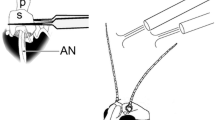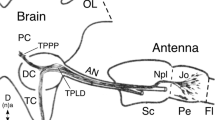Abstract
The olfactory pathway of the locust Locusta migratoria is characterized by a multiglomerular innervation of the antennal lobe (AL) by olfactory receptor neurons (ORNs). After crushing the antenna and thereby severing ORN axons, changes in the AL were monitored. First, volume changes were measured at different times post-crush with scanning laser optical tomography in 5th instar nymphs. AL volume decreased significantly to a minimum volume at 4 days post-crush, followed by an increase. Second, anterograde labeling was used to visualize details in the AL and antennal nerve (AN) during de- and regeneration. Within 24 h post-crush (hpc) the ORN fragments distal to the lesion degenerated. After 48 hpc, regenerating fibers grew through the crush site. In the AL, labeled ORN projections disappeared completely and reappeared after a few days. A weak topographic match between ORN origin on the antenna and the position of innervated glomeruli that was present in untreated controls did not reappear after regeneration. Third, the cell surface marker fasciclin I that is expressed in ORNs was used for quantifying purposes. Immunofluorescence was measured in the AL during de- and regeneration in adults and 5th instar nymphs: after a rapid but transient, decrease, it reappeared. Both processes happen faster in 5th instar nymphs than in adults.









Similar content being viewed by others
References
Anton S, Hansson BS (1996) Antennal lobe interneurons in the desert locust Schistocerca gregaria (Forskal): Processing of aggregation pheromones in adult males and females. J Comp Neurol 370:85–96
Anton S, Ignell R, Hansson BS (2002) Developmental changes in the structure and function of the central olfactory system in gregarious and solitary desert locusts. Microsc Res Tech 56:281–291. doi:10.1002/jemt.10032
Ayaz D, Leyssen M, Koch M, Yan J, Srahna M, Sheeba V, Fogle KJ, Holmes TC, Hassan BA (2008) Axonal injury and regeneration in the adult brain of Drosophila. J Neurosci 28:6010–6021
Bastiani MJ, Harrelson AL, Snow PM, Goodman CS (1987) Expression of fasciclin I and II glycoproteins on subsets of axon pathways during neuronal development in the grasshopper. Cell 48:745–755
Bittner GD (1991) Long-term survival of anucleate axons and its implication for nerve regeneration. Trends Neurosci 14:188–193
Blackmore M, Letourneau PC (2006) Changes within maturing neurons limit axonal regeneration in the developing spinal cord. J Neurobiol 66:348–360
Boeckh J, Tolbert LP (1993) Synaptic organization and development of the antennal lobe in insects. Microsc Res Tech 24:260–280. doi:10.1002/jemt.1070240305
Carbonetto S, Muller KJ (1972) A regenerating neurone in the leech can form an electrical synapse on its severed axon segment. Nature 267:450–451
Chapman RF, Greenwood M (1984) Differences in numbers of sensilla on the antennae of solitarious and gregarious Locusta migratoria L. (Orthoptera: Acrididae). Int J Insect Morphol Embryol 13:295–301
Chapman RF, Greenwood M (1986) Changes in distribution and abundance of antennal sensilla during growth of Locusta migratoria L. (Orthoptera : Acrididae). Int J Insect Morphol Embryol 15:83–96
Chiba A, Murphey RK (1991) Connectivity of identified central synapses in the cricket is normal following regeneration and blockade of presynaptic activity. J Neurobiol 22:130–142
Eickhoff R, Bicker G (2012) Developmental expression of cell recognition molecules in the mushroom body and antennal lobe of the locust Locusta migratoria. J Comp Neurol 520:2021–2040
Eickhoff R, Lorbeer RA, Scheiblich H, Heisterkamp A, Meyer H, Stern M, Bicker G (2012) Scanning laser optical tomography resolves structural plasticity during regeneration in an insect brain. PLoS ONE 7, e41236. doi:10.1371/journal.pone.0041236
Ernst KD, Boeckh J, Boeckh V (1977) A neuroanatomical study on the organization of the central antennal pathways in insects. Z Zellforsch 176:285–306
Fredman SM, Nutz PG (1988) Regeneration of identified neurons and their synaptic connections in the central nervous system of Aplysia. Am Zool 28:1099–1108
Galizia CG, Rössler W (2010) Parallel olfactory systems in insects: anatomy and function. Annu Rev Entomol 55:399–420
Gewecke M (1972) Bewegungsmechanismus und Gelenkrezeptoren der Antennen von Locusta migratoria L. (Insecta, Orthoptera). Z Morph Tiere 71:128–149
Ghannad-Rezaie M, Wang X, Mishra B, Collins C, Chronis N (2012) Microfluidic chips for in vivo imaging of cellular responses to neural injury in Drosophila larvae. PLoS ONE 7(1), e29869. doi:10.1371/journal.pone.0029869
Guthrie DM (1962) Regenerative growth in insect nerve axons. Insect Physiol 8:79–92
Hansson BS, Stensmyr MC (2011) Evolution of insect olfaction. Neuron 72:698–711. doi:10.1016/j.neuron.2011.11.003
Huetteroth W, Schachtner J (2005) Standard three-dimensional glomeruli of the Manduca sexta antennal lobe: a tool to study both developmental and adult neuronal plasticity. Cell Tissue Res 319:513–524
Ignell R, Anton S, Hansson BS (2001) The antennal lobe of Orthoptera - anatomy and evolution. Brain Behav Evol 57:1–17
Jacobs K, Lakes-Harlan R (1999) Axonal degeneration with tympanal nerve of Schistocerca gregaria. Cell Tissue Res 298:167–178
Jefferis GS, Hummel T (2006) Wiring specificity in the olfactory system. Semin Cell Dev Biol 17:50–65
Kirchhof B, Bicker G (1992) Growth properties of larval and adult locust neurons in primary cell culture. J Comp Neurol 323:411–422
Klagges BR, Heimbeck G, Godenschwege TA, Hofbauer A, Pflugfelder GO, Reifegerste R, Reisch D, Schaupp M, Buchner S, Buchner E (1996) Invertebrate synapsins: a single gene codes for several isoforms in Drosophila. J Neurosci 16:3154–3165
Komiyama T, Sweeney LB, Schuldiner O, Garcia KC, Luo L (2007) Graded expression of semaphorin-1a cell-autonomously directs dendritic targeting of olfactory projection neurons. Cell 128:399–410
Kraft R, Levine RB, Restifo LL (1998) The Steroid Hormone 20-Hydroxyecdysone Enhances Neurite Growth of Drosophila Mushroom Body Neurons Isolated during Metamorphosis. J Neurosci 18:8886–8899
Krüger S, Butler CS, Lakes-Harlan R (2011a) Morphological and physiological regeneration in the auditory system of adult Mecopoda elongata (Orthoptera: Tettigoniidae). J Comp Physiol A 197:181–192
Krüger S, Haller B, Lakes-Harlan R (2011b) Regeneration in the auditory system of nymphal and adult bush crickets Tettigonia viridissima. Physiol Entomol 36:235–246
Krüger S, Lakes-Harlan R (2010) Changes in the auditory neuropil after deafferentation in adult grasshoppers (Schistocerca gregaria). Arthropod Struct Dev 39:26–32
Lakes R, Kalmring K, Engelhardt KH (1990) Changes in the auditory system of locusts (Locusta migratoria and Schistocerca gregaria) after deafferentation. J Comp Physiol A 166:553–563
Lapper SR, Bolam JP (1991) The anterograde and retrograde transport of neurobiotin in the central nervous system of the rat: comparison with biocytin. J Neurosci Methods 39:163–174
Laurent G (1996) Dynamical representation of odors by oscillating and evolving neural assemblies. Trends Neurosci 19:489–496
Lorbeer RA, Heidrich M, Lorbeer C, Ramirez Ojeda DF, Bicker G, Meyer H, Heisterkamp A (2011) Highly efficient 3D fluorescence microscopy with a scanning laser optical tomograph. Opt Express 19:5419–5430
Newland PL (1991) Morphology and somatotopic organisation of the central projections of afferents from tactile hairs on the hind leg of the locust. J Comp Neurol 312:493–508
Newland PL, Rogers SM, Gaaboub I, Matheson T (2000) Parallel somatotopic maps of gustatory and mechanosensory neurons in the central nervous system of an insect. J Comp Neurol 425:82–96
Ostrowski D, Ehrenreich H, Heinrich R (2011) Erythropoietin promotes survival and regeneration of insect neurons in vivo and in vitro. Neuroscience 188:95–108
Ott SR (2008) Confocal microscopy in large insect brains: zinc-formaldehyde fixation improves synapsin immunostaining and preservation of morphology in whole-mounts. J Neurosci Methods 172:220–230. doi:10.1016/j.jneumeth.2008.04.031
Pätschke A, Bicker G, Stern M (2004) Axonal regeneration of proctolinergic neurons in the central nervous system of the locust. Brain Res Dev Brain Res 150:73–76
Rossignol S, Schwab M, Schwartz M, Fehlings MG (2007) Spinal cord injury: time to move? J Neurosci 27:11782–11792
Schachtner J, Schmidt M, Homberg U (2005) Organization and evolutionary trends of primary olfactory brain centers in Tetraconata (Crustacea þ Hexapoda). Arthropod Struct Dev 34:257–299
Schneider D (1964) Insect antennae. Annu Rev Entomol 9:103–122
Schürmann FW, Wechsler W (1970) Synapsen im Antennenhügel von Locusta migratoria (Orthoptera, Insecta). Z Zellforsch 108:563–581
Simões P, Ott SR, Niven JE (2011) Associative olfactory learning in the desert locust. Schistocerca gregaria. J Exp Biol 214:2495–2503. doi:10.1242/jeb.055806
Spira ME, Zeldes D, Hochner B, Dormann A (1987) The effects of microenvironment on the redifferentiation of regenerating neurones: neurite architecture, acetylcholine receptors and Ca2+ channel distribution. J Exp Biol 132:111–131
Stern M, Bicker G (2008) Nitric oxide regulates axonal regeneration in an insect embryonic CNS. Dev Neurosci 68:295–308
Stern M, Ediger VL, Gibbon CR, Blagburn JM, Bacon JP (1997) Regeneration of cercal filiform hair sensory neurons in the first-instar cockroach restores escape behaviour. J Neurobiol 33:439–458
Stern M, Scheiblich H, Eickhoff R, Diwischus N, Bicker G (2012) Regeneration of olfactory afferent axons in the locust brain. J Comp Neurol 520:679–693
Vosshall LB, Wong AM, Axel R (2000) An olfactory sensory map in the fly brain. Cell 102:147–159. doi:10.1016/S0092-8674(00)00021-0
Wang Z, Yang P, Chen D, Jiang F, Li Y, Wang X, Kang L (2015) Identification and functional analysis of olfactory receptor family reveal unusual characteristics of the olfactory system in the migratory locust. Cell Mol Life Sci 72:4429–4443. doi:10.1007/s00018-015-2009-9
Waller A (1850) Experiments on the section of glossopharyngeal and hypoglossal nerves of the frog and observations of the alternatives produced thereby in the structure of their primitive fibres. Philos Trans R Soc Lond B 140:423–429
Xiong X, Wang X, Ewanek R, Bhat P, DiAntonio A, Collins CA (2010) Protein turnover of the Wallenda/DLK kinase regulates a retrograde response to axonal injury. J Cell Biol 191:211–223
Zwart MF, Randlett O, Evers JF, Landgraf M (2013) Dendritic growth gated by a steroid hormone receptor underlies increases in activity in the developing Drosophila locomotor system. Proc Natl Acad Sci U S A 110:E3878–E3887. doi:10.1073/pnas.1311711110
Acknowledgements
The study was partially funded by the German Federal Ministry for Education and Research (BMBF grant 031L0062A).
Author information
Authors and Affiliations
Corresponding author
Ethics declarations
Conflict of interest
The authors declare that they have no conflict of interest.
Rights and permissions
About this article
Cite this article
Wasser, H., Biller, A., Antonopoulos, G. et al. Regeneration of axotomized olfactory neurons in young and adult locusts quantified by fasciclin I immunofluorescence. Cell Tissue Res 368, 1–12 (2017). https://doi.org/10.1007/s00441-016-2560-1
Received:
Accepted:
Published:
Issue Date:
DOI: https://doi.org/10.1007/s00441-016-2560-1




